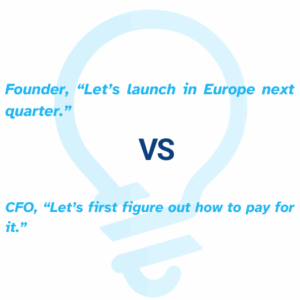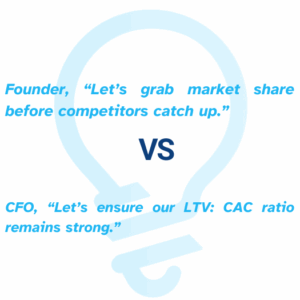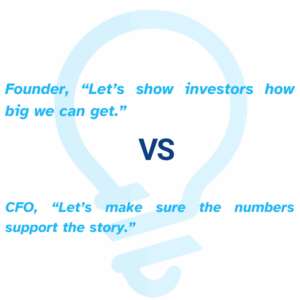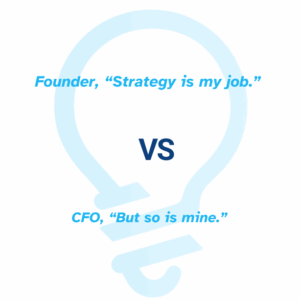In a high-growth SaaS startup, there are conflicts that threaten Founder and CFO alignment in SaaS. The founder provides the initial drive and innovative vision, while the CFO functions as a stabilizing force, ensuring prudent financial management and risk mitigation.
When these two are aligned, their partnership drives focus, fuels growth, and builds long-term value. However, conflicts will arise, and even a great product and generous funding won’t shield you from internal friction.
This dynamic often plays out like this: the visionary founder pursues ambitious ideas, while the operationally minded CFO insists on rigorously evaluating each one. While this tension can be productive, it can also hinder progress if not properly managed.
If you’re a SaaS founder, CEO, or CFO, it’s crucial to recognize the moments when collaboration breaks down and take steps to realign. Here are five common flashpoints that can derail even the most promising startup teams.
1. Balancing Founder Ambition and Financial Realities

Founders often pursue new opportunities, while CFOs focus on managing risks. Both roles are crucial, but their priorities can clash in high-pressure situations. Founders typically view possibilities for growth, whereas CFOs identify constraints. When this dynamic is recognized as a valuable tension, it can lead to effective collaboration; if ignored, it will cause frustration and hence threaten founder and CFO alignment in SaaS.
What Goes Wrong:
- Budgets can be overwhelmed by ambitious goals.
- Overly cautious planning can stifle innovation.
How to Address This
- Create a shared framework for prioritizing investments.
- Use scenario planning to model both best- and worst-case outcomes.
- CFOs should encourage strategic discussions rather than simply saying no.
- Founders should view financial modelling as a vital leadership tool, rather than as a barrier to their ambitions.
2. Blitzscaling vs. Financial Fitness

SaaS founders are often driven by a sense of urgency to grow quickly, win early, and achieve category dominance. While speed can create a competitive advantage, scaling without financial clarity can lead to significant challenges.
CFOs focus on sustainable unit economics such as gross margin, payback period, and long-term customer value. Founders may see these metrics as hindrances, while CFOs view them as essential guardrails.
What Goes Wrong:
- Runway disappears faster than expected.
- Rapid growth can mask underlying inefficiencies.
- Securing future funding becomes increasingly difficult.
How to Fix It:
- Make unit economics a regular topic of discussion in weekly leadership meetings, rather than just quarterly reviews.
- Utilize dashboards to monitor Customer Acquisition Cost payback period, and cash burn in real-time.
- Align on the milestones that justify additional investment in growth.
The best SaaS companies involve their finance teams in growth planning, not just as gatekeepers. Financial health is a strategic asset, not merely a compliance function.
3. Narrative Crafting vs. Data Grounding

Every founder needs to tell a compelling story to customers, to the team, and especially to investors. But if the story stretches beyond the numbers, CFOs are left to clean up the credibility gap.
This isn’t about dishonesty; it’s about overpromising without alignment. And in today’s investor environment, due diligence is more rigorous than ever.
What Goes Wrong:
Investor trust erodes. Employees feel whiplash. Forecasts lose credibility.
How to Fix It:
- CFOs should be looped into pitch decks and roadshows early, not just handed to them after the fact.
- Founders should use CFOs as strategic partners in crafting growth narratives, especially when tying forecasts to KPIs.
- Build in space for challenging the assumptions behind the vision and use those conversations to strengthen your story.
4. Strategic Turf Wars

As CFOs of SaaS companies evolve from traditional back-office roles, their responsibilities increasingly overlap with strategic functions. They are responsible for providing insights, forecasting outcomes, and often identifying risks before the rest of the team.
However, the founders. especially those with backgrounds in product development or market strategy may perceive strategic planning as their sole domain. If this difference in perspective is not addressed, it can lead to tension over who is in charge of what.
What Goes Wrong:
- Key decisions are made in isolation.
- Long-term plans lack financial rigor.
- CFOs may feel sidelined, while founders might feel second-guessed.
How to Fix It:
Define clear roles: clarify who leads, who provides input, and who makes decisions.
Establish weekly strategy meetings between the founder/CEO and the CFO to foster shared ownership.
Allow CFOs to contribute to product and go-to-market (GTM) strategy discussions, and encourage founders to engage in financial modelling discussions.
Today, strategy is a shared responsibility. A founder who invites financial perspectives at an early stage and a CFO who thoughtfully engages in strategic discussions can cultivate a culture of healthy challenge and mutual success.
5. Speed vs. Scrutiny

In a startup, speed is essential for survival. Founders often juggle urgent requests from investors, customers, and teams and need decisions made quickly. On the other hand, CFOs are trained to validate, reconcile, and triple-check information before acting, which can clash with the founder’s urgency.
What Goes Wrong:
- Decisions get delayed.
- Data becomes mistrusted.
- Teams feel stuck in analysis or lack direction.
How to Fix It:
- Agree on what constitutes a fast decision versus a high-stakes one.
- Implement tiered decision timelines: “fast,” “medium,” and “deliberate.”
- Use pre-aligned dashboards to minimize friction when time is short.
Tension Isn’t the Problem, Avoiding It Is
When founders and CFOs avoid tension, it can lead to bigger issues over time. However, when they confront it together, it can become a powerful catalyst for growth.
You don’t need to be in total agreement, but it’s essential to communicate regularly, align priorities, and build trust in each other’s areas of expertise.
The best SaaS companies find a balance between vision and viability. They understand that sustainable growth doesn’t stem from a single voice; rather, it arises from two roles that challenge and complement each other week after week.
Alignment Tools to Consider:
- Weekly one-on-one meetings between the Founder/CEO and CFO
- Shared financial dashboards (including key performance indicators tied to growth milestones)
- Clear accountability regarding product strategy, pricing, and forecasting
- Transparent narratives supported by data that can withstand scrutiny
When founders and CFOs work in harmony, they don’t just protect the company; they drive growth with clarity and conviction. This helps avoid these conflicts that undermine founder and CFO alignment in SaaS. Contact our Dallas office for a complimentary CFO consultation to explore the benefits of Fractional Accounting with Bright Balance today!





